Creating a positive association between your dog and a crate is rather important, it’s also important for toilet training.
Crate training can be a fun and positive process for both you and your dog.
Most people think of crate training as a way to house train their dog, but it can be so much more than that.
A crate can provide your dog with a safe and comfortable place to sleep and relax, and it can also be a great tool for training. Crate training can help prevent or cure separation anxiety. By using positive reinforcement, you can make the crate training process fun and reward for your dog. In this article, we’ll go over how to crate train and offer some tips for making it a success.
What Is Crate Training?
Crate training is the process by which we adjust and desensitise our dogs to associate a crate (kennel, den, whatever you wish to call it!) a comfortable space for them.
Oftentimes this is used for their bed, safe space and zone of zen in and around your home and as a management solution for toilet training and sometimes for balancing the needs of your household (such as keeping a rambunctious puppy away whilst your toddler is having tummy time!).
However, they are also used for safe transport, at the vets and groomers, by emergency rescue services and for recovery after surgery.
Primarily because of the emergency rescue scenario, I would recommend that you adjust your dog to being in a crate, and taught to feel comfortable in this sort of space.
Why Should I Crate Train My Puppy or Dog?
Crate training can be a great way to manage your dog, train behaviours, and manage recovery. Ultimately, to crate train, or not crate train is your decision. Crate training does offer a lot of benefits, so let’s have a look at them.
- Safe space from home ongoings,
- Secure travel,
- Less stressful when in vets/groomers,
- Useful for housetraining,
- Useful for confining, esp. in open plan homes,
- Transferable skillset,
- Conditions a 'calm zone',
- Creates an 'air lock' for escape artists/door dashers,
- Management in multidog homes,
- Recovery from illness/injury/surgery,
- Emergency rescue of dogs requires them to be crated,
- Prevents scavenging at home.
- Manages destructive behaviors
- Can be stressful,
- Can make separation anxiety worse,
- Can be an intrusion on your home,
- Not strictly necessary to complete any of the pros raised.
Let’s be clear here, the last con on that list? Is a big problem.
Some trainers believe that because of this, that crates should not be used.
For my opinion? Crate training is useful.
Yes, it can be overdone, yes, it can be abused, but so can any tool.
The important thing is that we teach our dogs to be responsible around the home in the long term, and work them through whatever issues they have that we’re using the crate for, whether that’s toilet training or the fact that they chew your skirting boards when not attended.
And that goes for all training tools.
Note: If you’re struggling with destructive behaviours, or separation anxiety, it might be a good idea to get the services of a pet sitter or dog walker, and look into dog training!
How Long Can Puppy Be In Their Crate?
This is a wonderful question because it shows you want to be responsible! Here’s my ‘golden ratios’ for the amount of time your dog can spend in a crate vs out of their crate to roughly help you.
| Puppy Age | Ratio of out of crate to in crate |
| 2 Months | 1:2 |
| 3 Months | 1:2 |
| 4 Months | 1:1 |
| 5 Months | 1:1 |
| 6 Months | 3:2 |
Okay, so what this means in words is at two months of age, puppy can spend one hour out of crate and two hours in their crate – this should never be longer than that at this stage because puppies cannot hold their bladder for any longer than this.
As puppy creeps up in age, they can be in there longer – but I really would advise understanding that your puppy is a member of your family, and he or she will never learn to be that and be good at that if you don’t afford them the opportunity to learn how to do so. You must integrate them.
That’s why you got a dog after all, right? An adorable, fluffy, loving family member? So ensure you Un-Crate Train too.
How To Crate Train Your Dog
Step One: Choose the right crate
There are many options for crate training and they come in multiple price ranges and with varied features. The three most common options for a dog crate includes wire crates, plastic crates and heavy duty crates.
| Image | Crate Type | Features | Price |
|---|---|---|---|
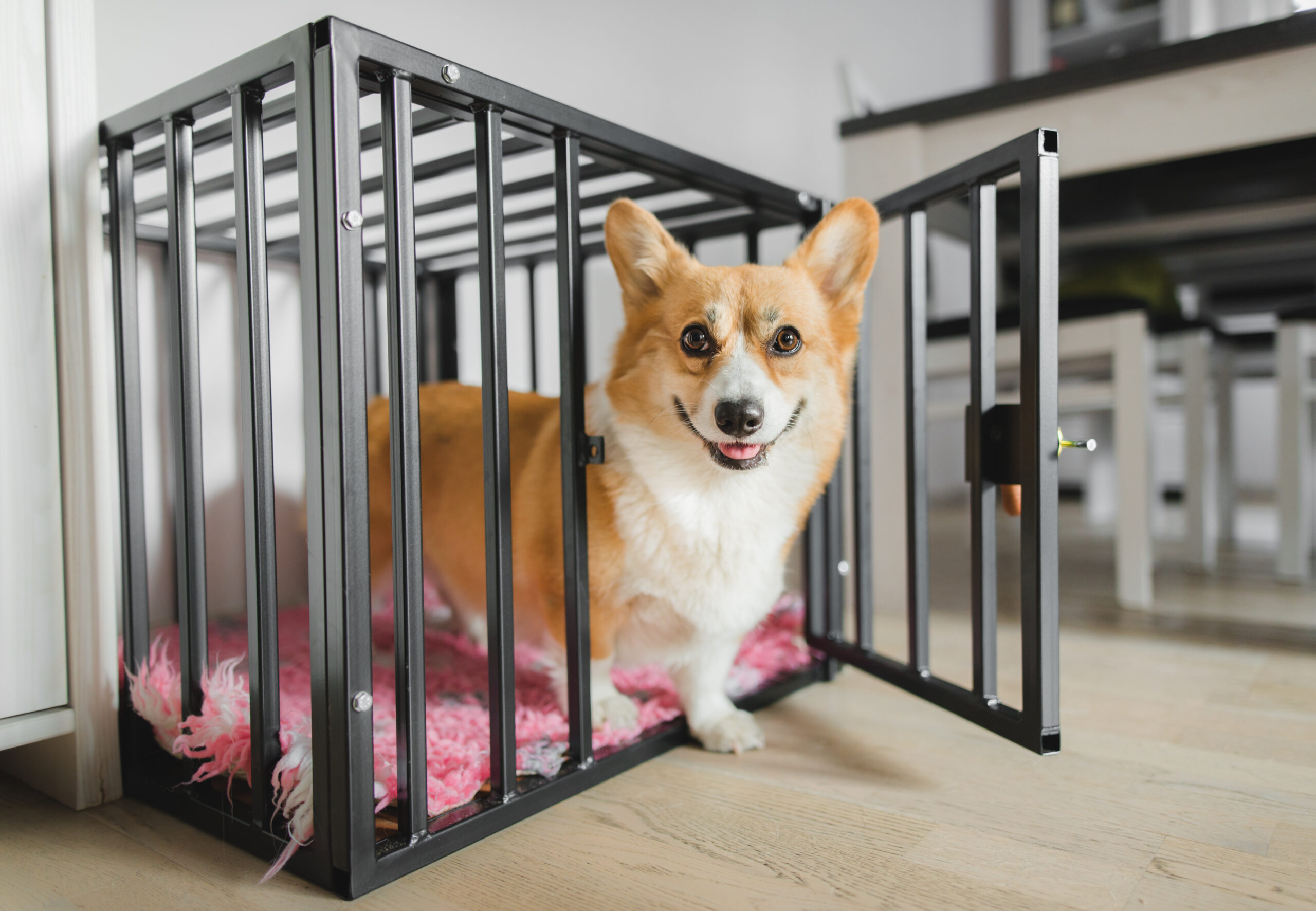 | Check Price | ||
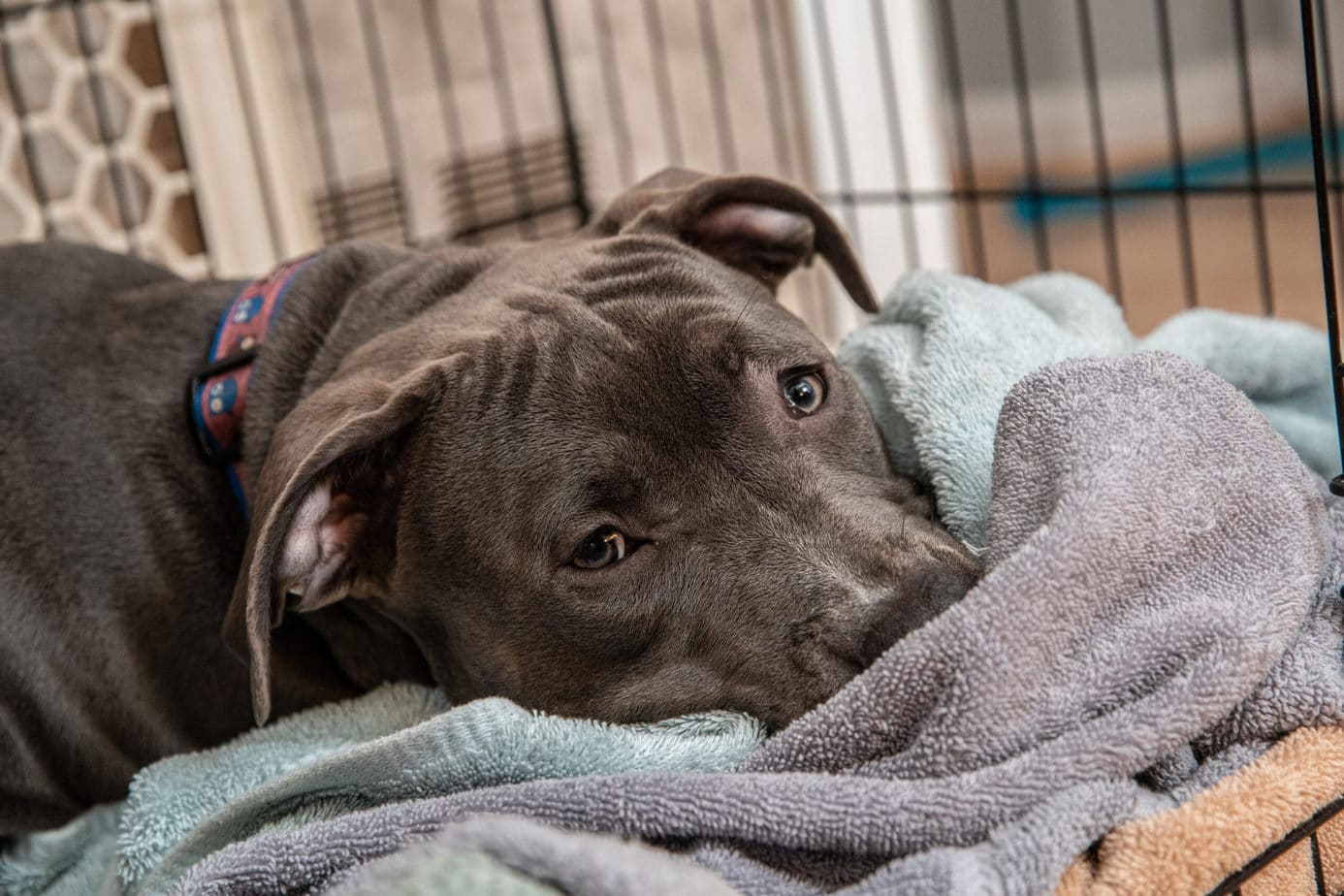 | Check Price | ||
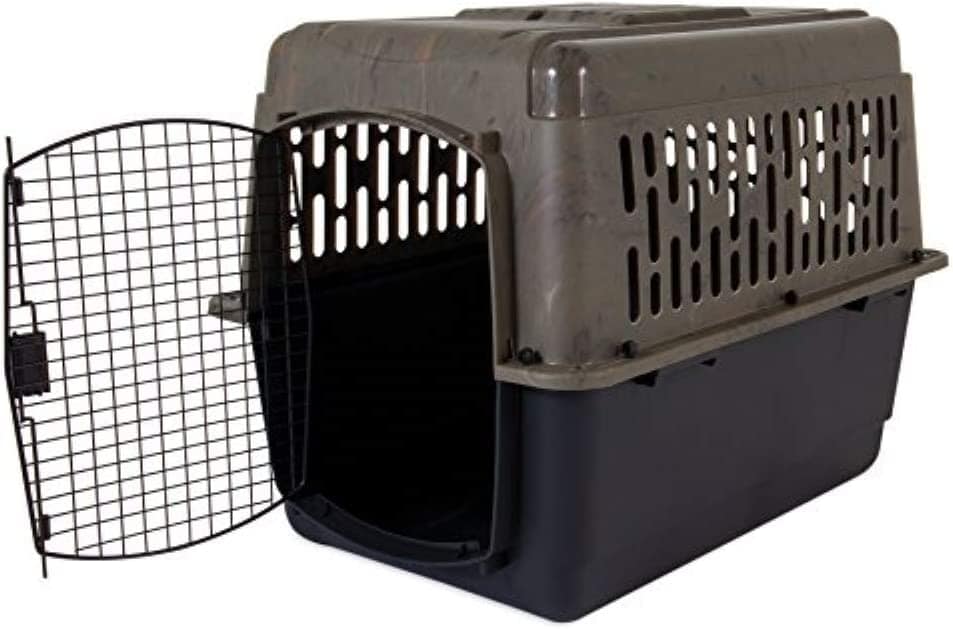 | Check Price |
If you are training a small puppy or toy breed, any crate may work for you! A bigger puppy or strong adult dog may need a plastic or heavy duty crate.
A wire or heavy duty metal crate can also work if you cover it with a pre-made cover or a blanket.
If you have a strong puppy or dog that might struggle to escape the crate, a wire crate is not suggested. The wire is often too easy to bend and the entire crate may come apart.
What If My Dog Has A Fear Of Crates Or Can Break Out Of Them?
In this instance, it’s really not recommended to simply strengthen the crate. That’s not appropriate.
The way to look at this is to look at this is to figure out what the reason for breaking out of the crate is, and work that out from base principles.
Step Two: Think Ahead
Before you even begin, remember that it is never a good idea to use punishment or negative reinforcement or force to crate train. You also must establish your dog’s crate as a safe place with good things available. If we use it as a negative time-out space, the dog may learn to fear it.
Step Three: First Steps to Training
Whether introducing a puppy or an adult dog, you can start by helping them see the crate is nothing to fear. If you are working with an older dog who is fearful, you may need to take more time. Open the crate door and let them see inside. Talk to them in a happy tone! Reassure and keep a happy tone of voice – because this is a big deal!
See if they will sniff inside the crate and, if they do, praise them. Place a treat just inside the crate and then just walk away. After a few attempts, put the canine in the crate for short periods of time. Some can go for quite a while and some nervous dogs may need to start with only a few minutes. You will gradually increase the time as they get more comfortable.
Step Four: Utilizing the Crate Effectively
Crate training will help you with potty training, safety training and sleep training.
The crate offers a place for them to have this time while you run errands, work or just can’t watch your dog. If your dog is not fully potty trained, they are still unlikely to potty inside the crate as long as you use one of the proper size.
For toilet training, they should have room to turn around and stand up, but not much more. This will let them understand that the crate is a place for sleep. Dogs naturally do not potty where they sleep.
Reward your dog with treats and excitement when they go to the bathroom outside or in their designated potty area – but this should help too; Puppy Toilet Training Do’s & Don’ts.
For all dogs, give them encouragement and happy praise when they enter the crate. When you open the crate door, walk away without fuss. Some will choose to stay in the crate and others will come right out. Once a dog is trained, some choose to spend lots of time in the crate and some don’t. They all need a positive association with the crate.
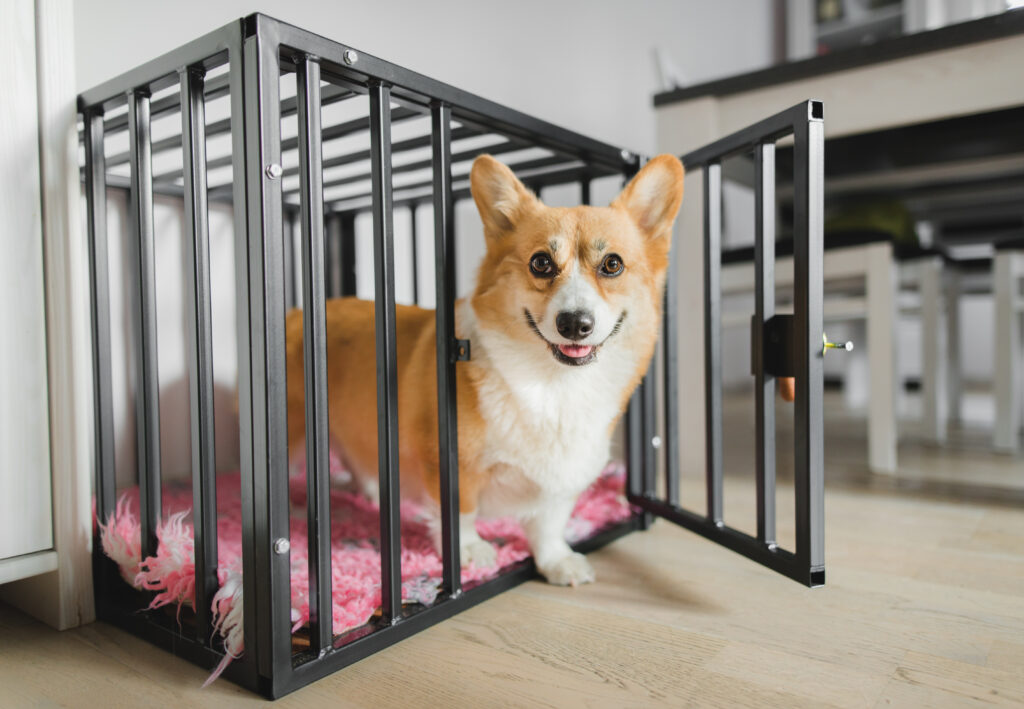
Step Five: Testing Positive Reinforcement Items
Many puppies will do well with a favorite toy and dog chews available inside the crate, so they don’t get bored or restless. Older dogs may enjoy this as well. See what is a good idea for yours to have a happy ongoing crate experience.
Step Six: Watch & Learn
As you get further, note what works for your dog and what might need to be changed. Some dogs will do best with comfortable blankets, a bed, plush toys, etc. Some dogs will tear these items up, pee on them, or just get uncomfortable with items in the crate.
Take note of your dog’s personal needs and add or remove bedding and comfort items as needed. Don’t worry if your dog needs an empty crate. Many dogs prefer a cool, flat surface.
Also, remember that soft blankets are a great idea to stop beds from mysteriously exploding too.
Step Seven: Working Toward Long-Term Training
Be consistent with your commands and rewards, and remain patient throughout the process as you repeat the process multiple times in a day and overnight. Young dogs will need more changes to get outside the puppy’s crate for stretching and potty time. With patience, your dog will be able to have crate time for a few hours at a time.
Step Eight: Crate Games & Activities
You can use fun activities to make crate time a great time for your dog! Use a command to tell the dog to go in the crate (“Crate time!” for example) and if they step inside, immediately give them a special treat or favorite toy.
But there are plenty of other things you can do to craft a positive experience
- Throw a ball or chew inside the crate and let them retrieve it and enjoy it wherever they wish.
- Hide treats inside the crate, on their bed or under blankets.
- Add in random hiding things throughout the day.
- Give special treats inside the crate, such as a stuffed kong – peanut butter is a great choice too!
If not, give encouragement until they understand the game. These games make a crate a happy place.

Step Nine: Challenges
If your dog exhibits frustration or fear during the crate training process, go back to step one. Start again with lots of positive reinforcement and short time. Never use the crate to punish the animal and never force them inside the crate. Adjust the length of time slowly. It can take months to get a dog fully crate training, but it is worth it!
Crate training a dog doesn’t have to be difficult, but it’s important to stick with the steps and remain consistent. Following these tips should help you create a safe and happy environment for your pup while they’re getting used to their new home.
Crate Training Frequently Asked Questions
Can I Move My Puppy’s Crate Around?
You can! And I would suggest you do if they will sleep in your bedroom at night and in the family room during the day – keeping this consistent can decrease confusion and increase the likelihood of successfully crate training!
Then, as your puppy gets comfortable, you can move the crate away from your room and into whatever space you plan on putting them into long term.
How Old Does My Puppy Need To Be Before I can Crate Train?
Puppies can be crate trained by your breeder – this does not mean that they will be entirely happy in their crate from their first night at home, alone from their siblings. However, if you breeder provides a blanket from puppy’s mother, and you provide some things that smell of you, and you consider getting a heartbeat toy, you might well manage to overcome this easily enough.
In essence, as soon as puppy is cognizant and aware (so around 5 weeks) you can begin to be really successful with crate training.
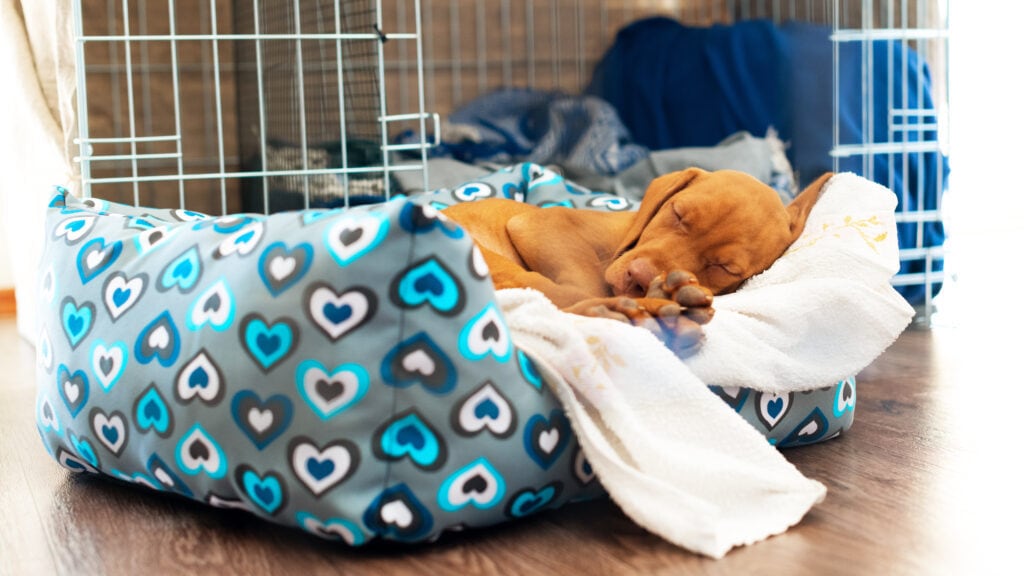
How Big Should My Puppy’s Crate Be?
This is the age old question. This honestly depends on how you’re going to use it. If you intend on keeping it as a permanent fixture, then judge off of breed size, parent size, or gen an idea of how big puppy’s going to be and buy something at a comfortable size for their maximum size (This shouldn’t be snug, and should be as big as the space allows for).
If you don’t intend on keeping the crate as a permanent fixture, you may be able to buy a slightly smaller one than their maximum size if training goes well.
I would suggest, however that you consider keeping the crate (provided you have place to store it, because they are pretty unwieldy!) as you may one day need it for veterinary reasons – and I promise you your insurance won’t cover the cost of it.
How Do I Stop My Puppy From Whining In Their Crate?
First, you have to make their crate their wonderful little cozy home of glory. How do you do that?
Well, you follow the steps set out in this piece. You make sure that the crate’s well located. Then you make sure you adhere to The Golden Rules Of Crate Training Your Puppy and Puppy Toilet Training Do’s & Don’ts – then you’re going to have to look a little deeper. Are you satisfying your puppy’s needs? Do they really need a nap, or is it time for them to be up and awake?
What Bedding Should I Use For My Puppy’s Crate?
This depends on what your puppy prefers, some pups like a thing to lean on and a bed with bolsters can be a great idea, some get overheated and will move all of the stuff aside to sleep on the cooler crate tray. Personally, I like to put in a mattress style bed (something nice and supportive) and a lighter blanket. I’m a big fan of letting woofs make their own decisions, and this combo is something that mainly allows that to happen.
The only thing I will emphasise to only ever get fitted crate covers, because loose blankets through the bars can (and often will) be pulled through the bars and can represent a choking hazard or strangulation risk. It’s not pleasant, so just do the little bit of extra investment, it looks much prettier anyway!

What Should I Put In My Puppy’s Crate Overnight?
When the mission is to help puppy sleep for longer periods of time, I avoid putting in water or food, I would advise against puppy pads too, by the way. But considering things like
- A heartbeat toy
- A blanket from mother & littermates
- A tshirt that smells of you or a family member.
- A safe chew!
All of these may come in handy and encourage puppy to settle nicely.
And Presto! You Have A Crate Trained Dog or Puppy!
So, whether you’re looking for a new crate, working with an adult dog, an old dog or brand new, young puppies – it’s doable. And If you are struggling to make it work, go back to base principles and build it up.
Adult dogs do typically train quicker than puppies. A lot of times crates arent needed in a day to day life of an adult dog – certainly my lot don’t sleep in a crate typically. but they do occasionally choose to sleep there – and even find yummy treats there from time to time.
If you need help crate training your dog or puppy, this would be a perfect thing to do a bark day with! We can deep dive into your dogs behaviour and figure out the path on the way forwards.

Author, Ali Smith
Ali Smith is a professional, qualified, and multi-award winning trainer is the founder of rebarkable. She has always believed animals deserve kindness and champions force free methods. Believing that dog guardians will all choose the kindest options if proper information is provided, she aims to help all dog guardians who need it and make dog training as accessible as possible
Ali lives win Maryland, US with her husband and her three dogs.

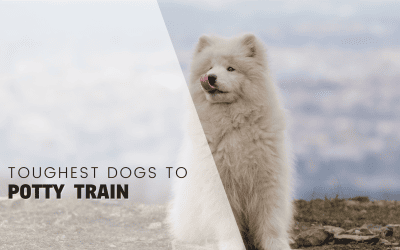




0 Comments